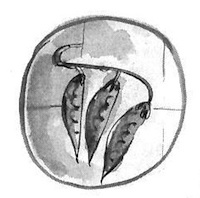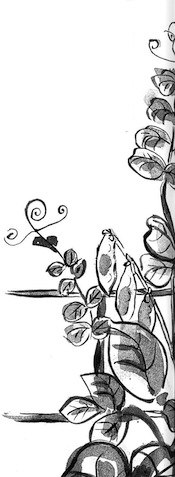
At Tassajara Zen Mountain Center, I worked in the garden with a woman about ten years older than me and a very serious Zen student. Marga was an ordained priest who wasn’t thrilled about being assigned to work in the garden with a brand-new Zen student as her supervisor, and I was always a little tentative around her. She was formidable and ruthlessly methodical. Whenever she questioned my stammered directions, she would raise both eyebrows at me, slowly, like a heavy velvet curtain rising on a performance of Waiting for Godot. But Marga believed in the dignity of real work, so she followed my directions efficiently and energetically.

On a cold February morning, when ice puddled under the dark zendo eaves, I showed Marga how to sow snow peas on a south-facing fence line in the upper garden. Three weeks later, when the peas pushed through the cold crust of their garden soil and unfurled in the low light of the winter sun, Marga was the first to report their germination to me. She had been checking the pea line every night after zazen and a few times during the day, as though her faith in herself and in the truth of the living garden depended on that one slender line of Oregon dwarf gray sugar peas. When they sprouted, so did she. “What amazes me the most,” she confessed, “is that these peas had been growing all the time, long before I saw them come up.” While struggling over whether to become a Zen priest, she had suffered a great deal of knee pain during the long meditation periods at Tassajara. She decided that zazen was easy for Asians who were born to sit, but torture for Westerners. She based this observation on the apparent ease with which a visiting Japanese Zen master sat zazen. “He sits,” she said, “like a stone mountain.”
One day during a week-long sesshin, Marga was assigned to patrol the zendo to help keep flagging meditators from drifting off to sleep. On her rounds, she paused in front of the roshi’s seat. He was facing out, anchoring the zendo. “I noticed how still he was, how solid. And even though it was winter, and very cold, he had beads of sweat on his forehead and all above his lip. After that day, my meditation cracked open. It started to grow.” It was as though he had warmed the ground of her uncertain practice with the intensity of his own effort.
Marga told me this story while we were harvesting peas from her winter pea line. The twining vines were five feet high now, bending with a heavy load of flat translucent pea pods, back lit by the stray sunlight of early summer. I looked over at Marga, who was flushed with blood, very alive. I attributed this pink liveliness to the groaning harvest of peas and to the mystery of the growing garden that circulates and pumps through every true gardener’s veins
Thank you for subscribing to Tricycle! As a nonprofit, we depend on readers like you to keep Buddhist teachings and practices widely available.